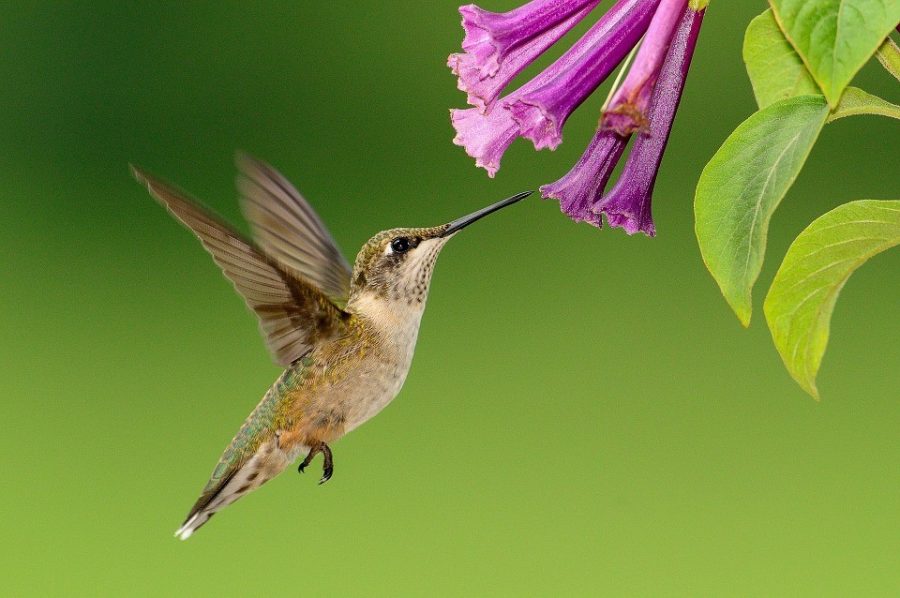While 2017 might be the Year of the Rooster according to the Chinese zodiac, the Tucson Audobon Society has dubbed it the “Year of the Hummingbird.” These local bird conservationists work in the community to engage and educate Tucsonans in order to promote the protection of bird habitats.
The hummingbird was chosen as this year’s highlighted family because of its unfaltering accessibility and magnificence, according to Jennie MacFarland, bird conservation biologist for the Tucson Audubon Society.
Hummingbirds captivate us at our windowsills and gardens, but these birds’ lifestyles are even more fascinating than their ability to hover in place. Some of these little spark plugs migrate all the way from central Mexico to Alaska.
The ruby-throated hummingbird, affectionately nicknamed the “hungry bird,” has a metabolism 100 times faster than an elephant. These birds need to eat twice their body weight each day to keep their hearts beating at super speed.
RELATED: Biologists find key traits for species success
Hummingbirds have also adapted a way to conserve energy when they are unsuccessful in locating food. The birds can go into a sleep-like state called torpor, where their heartbeats drop from approximately 500 beats per minute to only 50.
The most common species seen on campus is the Anna’s hummingbird, which is marked by its green back and red or gray underparts. Others include the broad-billed hummingbird, which is green with a red bill, and Costa’s hummingbird, which features a purple head and dark tail.
However, watching for hummingbirds always provides a chance for rarities, giving the birds of Tucson a seemingly endless spectrum of brilliant color.
Although hummingbirds are often admired for their aesthetic beauty, it is their athleticism that sets them apart from other birds.
“The smallest birds in the world are hummingbirds,” MacFarland said. “Their powers of flight are amazing; they can hover better than any other birds and are the only birds that can fly backwards.”
From a zoological perspective, hummingbirds are almost oxymoronic in their speed and endurance. They are nature’s long distance sprinters.
Spotting a hummingbird is not an uncommon encounter on the UA campus. From early spring to late summer, Tucson tantalizes urban wildlife with its abundance of blooming flora, providing nectar for over a dozen species of hummingbirds.
“Tucson really is the best major city for hummingbirds in the United States,” MacFarland said.
MacFarland also suggested the UA campus Women’s Plaza of Honor as a good place on campus to see hummingbirds because of its abundance of nectar-producing plants.
RELATED: UA experts discuss the state of buffelgrass around Tucson
Spotting a hummingbird can be a lot like seeing a shooting star; it takes a keen eye and plenty of patience.
Fortunately, several places in Tucson provide the opportunity to see a great deal of the little birds.
“Some really good places to go and see a lot of hummingbirds are the Tucson Audubon Society’s Mason Center in the northwest part of town, the Tucson Audubon nature shop close to the UA on University [Blvd], the Desert Museum, and Madera Canyon in Green Valley,” MacFarland said.
She also gave some tips on how one might attract hummingbirds to their home. She said plants are a very low-maintenance way to attract them.
Some native plants that don’t require much water —and that hummingbirds love—are chuparosa and salvia. Another great way to attract hummingbirds to your home is with bird feeders, according to MacFarland. By using a solution of four parts water and one part table sugar, anyone can make their home a hummingbird hotspot. However, everything isn’t so sweet for the animals.
While hummingbirds usually fare well in urbanized environments, they aren’t unaffected by climate change. MacFarland said this is especially true for migrating species because they’re dependent on resources being available along the way.
MacFarland also highlighted her concern for the ever-increasing conversion of nesting grounds into industrial and agricultural areas.
“Our main mission is for people to enjoy and appreciate birds and to encourage as many people as possible to care about birds and their habitats,” MacFarland said.
The Tucson Audubon Society is currently holding a winter/spring hummingbird photo competition. They also provide guided bird-watching tours and educational materials for the public. For more details, or for images of Tucson-area hummingbirds, visit their website at tucsonaudobon.org.
Follow Chandler Donald on Twitter.









